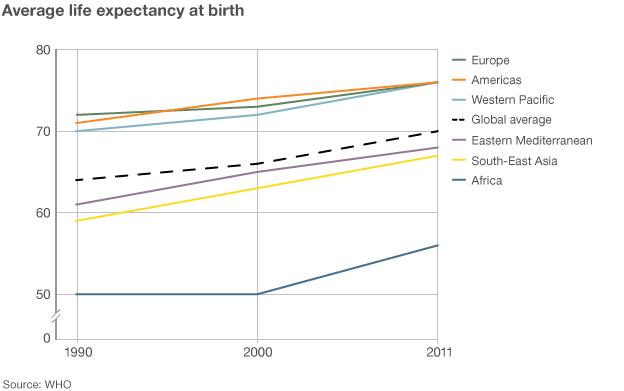Where are the missing 90-year-olds?
- Published

Thousands of elderly people are missing. The last UK census found far fewer people in their 90s than expected, and the same thing happened in the US with people over 100. Could this be an early sign that gains in life expectancy made in recent decades will not be repeated in future?
We've seen amazing improvements in life expectancy over the past few decades.
Six years have been added to global average life expectancy at birth, over the past two decades.
Much of this increase has been down to improvements in child mortality in low- and middle- income countries.
But in countries like the UK, post-retirement life expectancy has also increased rapidly.
"Life expectancy of a man aged 65 has increased from 14 years in the early 1980s to 21 years now - so that's a 50% jump in just three decades," says Richard Willets, director of longevity at insurance company Partnership.
Which is why, when the 2011 census was published, he went straight to the statistics about elderly populations.
And there the data revealed a surprise.
"There were 30,000 fewer people aged in their 90s than previously believed," he says - 429,000 instead of 457,000.
"That was about 15% fewer men; 5% fewer females. There were also fewer centenarians than previously believed - the number of female centenarians was [out] by about 10%."
Something similar has happened in the United States.
A projection made in 2004 suggested that by 2010, there would be around 114,000 people aged 100 or over, Willets says.
But, in reality, the 2010 census counted less than half that number.
Where have they all gone?

Sadly, they've already died. They just didn't live as long as statisticians had predicted.
Between censuses, annual population estimates are made by taking the numbers from the last census (which are, in part, estimates), and applying mortality tables, information from registered deaths and immigration data.
None of that information is perfect. So the further you get from the census year, the fuzzier the numbers become.
And because the numbers of people aged 90 and above are so small, any small estimation errors in how many people have died result in large discrepancies between the estimated number of people still alive - and the actual number.
"When I looked into why this may have happened, it quickly became apparent that the previous estimates of the number of people alive at different ages was subject to considerable uncertainty because of the approach that's taken to produce those estimates," says Willets, who has written about his discovery in The Actuary., external
In other words, the mortality and life expectancy calculations actuaries and statisticians rely on have been too optimistic.
Willets expects to see some revisions made in the light of his find.
"I think it's not inconceivable that we move from a situation where we're adding an extra year of life expectancy in retirement every three or maybe four years, to one where it takes five, six, seven, eight years, perhaps, to add that extra year of life expectancy," he says.

This would break an incredible long-running trend for the world's richest countries.
"Life expectancy has been increasing in the past in countries doing well by 2.5 years per decade, three months per year, which is really quite remarkable - six hours per day," according to Professor James Vaupel, director of the Max Planck Institute for Demographic Research in Germany, who's been tracking it.
This trend has been constant over the past 200 years - but for changing reasons. First, child and maternal mortality started improving, then, in the second half of the 20th Century, smoking rates began to drop.
"The last couple of years on that graph, there is a possible slowdown," says Colin Mathers a senior scientist at the World Health Organization (WHO) says.
"But it's hard to tell - we need a few more years of data to see. It's possible that some of the reductions - particularly in cardiovascular disease associated with reductions in smoking, in control of blood pressure particularly - have reached a saturation point.
"In Australia or California, for example, smoking rates are quite low - they could go lower, but it might not have much more impact on death rates. Perhaps control of cholesterol or blood sugar might kick in and start to further improve life expectancy. On the other hand, we're seeing increasing levels of obesity and less exercising at population level."
But the expert view is that the story of fast-increasing life expectancy certainly isn't over for the world's low- and middle- income countries. In fact, it's probably just beginning.

Over the past two decades, substantial improvements have been made to health in Africa, Asia, Latin America and the eastern Mediterranean region in particular, Mathers says.
Life expectancy at birth in Asia has increased by about seven years since 1990. India, China, Indonesia, the Philippines and Malaysia are all stand-out countries. Average life expectancy at birth has also increased by seven years in Eastern Mediterranean countries.
"In some of the poorest countries we are seeing reductions in child and maternal death rates and these are contributing to improvements in life expectancy," Mathers says.
"In some of the middle income countries, and countries which are developing very fast like China and some of the South American countries, we're seeing improvements in living conditions and medical care which are starting to contribute to very substantial reductions in adult mortality rates as well."
Africa is also a success story: life expectancy at birth has increased by six years from 50 years to 56 years in the short period, 1990-2011.
But these averages hide individual tales of tragedy at a country level: going against this trend, there are a number of African countries where life expectancy has fallen over the same period, largely due to HIV/Aids.
"In South Africa, for example, over the past 20 years, life expectancy has decreased by five years, almost entirely due to the HIV epidemic. And in Zimbabwe also, life expectancy has decreased by six years," Mathers says.
"In Nigeria on the other hand, life expectancy was much lower in 1990, at 46 years - there were very high levels of child, and adult, mortality. And that has improved to 53 years. So that's a seven-year increase for Nigeria, compared to a five-year decrease for South Africa."
But Nigerian life expectancy is still five years lower than that in South Africa, he points out.
You can follow the Magazine on Twitter , externaland on Facebook, external